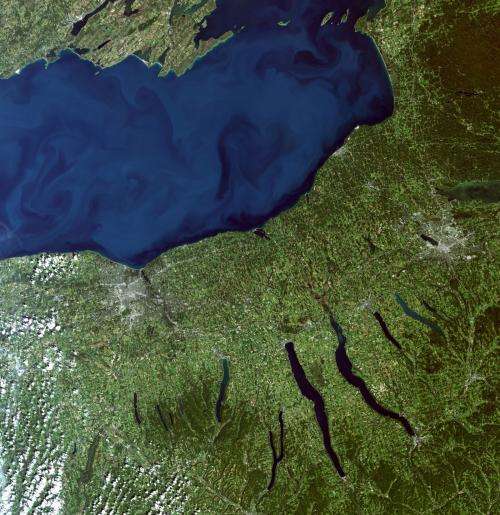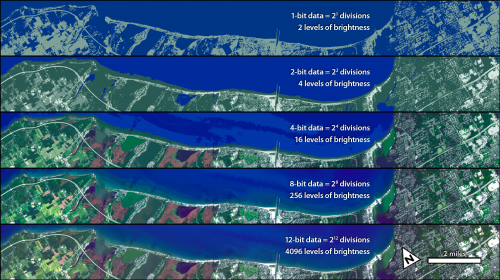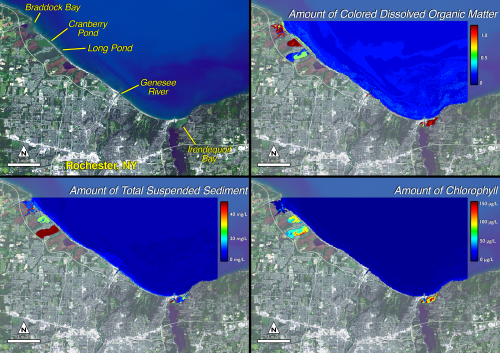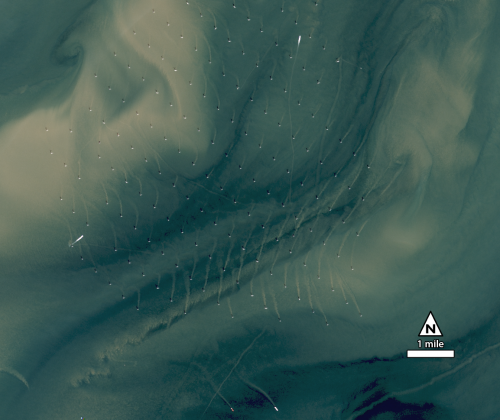Taking NASA-USGS's Landsat 8 to the beach

Some things go swimmingly with a summer trip to the beach – sunscreen, mystery novels, cold beverages and sandcastles. Other things – like aquatic algae – are best avoided.
The Landsat 8 satellite is helping researchers spot these organisms from space, gathering information that could direct beachgoers away from contaminated bays and beaches. With improved sensors and technology on the latest Landsat satellite, researchers can now distinguish slight variations in the color of coastal water due to algae or sediments to identify potential problem areas.
"We can sample everything in the blink of an eye and can say right here your yellow organic [contaminants] are looking high," said John Schott, a researcher at the Rochester Institute of Technology in New York. "We could use that to guide water managers' sampling, and say we think there's likely a problem along this stretch of beach."
Water challenges
Remote sensing satellites like Landsat 8, built by NASA and operated by the U.S. Geological Survey, detect the intensity of different wavelengths of light that reflect off Earth's surface. Over forests or grasslands, for example, the satellite will detect strong signals in the green band, since chlorophyll in leaves absorbs red and blue, but reflects green.
Water, however, poses a challenge. Water absorbs a lot of light, Schott said, and so oceans and lakes look dark on satellite images compared to land. Still, Landsat satellites pick up some light that's reflected off water – and Landsat 8 has a new band designed to pick up even more above coastal areas. This latest satellite can also detect more of the subtle differences between levels of a given color intensity that would indicate what was mixed in with the water.
"All of the interesting stuff is typically lost in the noise of the old instruments," said Schott, a Landsat Science Team member. While the old satellites might have allowed scientists to classify coastal waters into a handful of categories, Landsat 8 data can expand that to tens or hundreds of categories, he said.
"Now we've got a possibility to see and possibly suss out what's causing color changes," Schott said. "It's a potential revolution for doing water. No matter how hard we worked, we could only get so far with the old system."
Landsat 8 instruments were designed to detect more gradations in light intensity to improve results like this over both land and water, said Jim Irons, Landsat 8 project scientist. Not only did engineers and developers improve the instrument's detectors to pick up more shades, but they also changed how the instruments scan the Earth's surface. The Landsat 7 Enhanced Thematic Mapper-Plus sensor used a rapidly vibrating mirror to sweep the view of a few detectors across a swath of land to create an image. In contrast, the Landsat 8 instruments – the Operational Land Imager and Thermal Infrared Sensor – use long rows of detectors to observe the swath in a fixed line, moving like a pushbroom. This arrangement allows the detectors to linger just a bit longer over each parcel of land, Irons said, which improves the signal while cutting down on the static noise.
Landsat 8 also added a spectral band to pick up dark blue colors to help studies like Schott's that are looking at coastal areas, both of lakes and oceans. Pollutants from land impact fresh and salt-water ecosystems including coral reefs. "Water quality in the coastal regions is key to the health of the ocean," Irons said.
Water's color wheel
Beyond the blue of the water, Schott is paying attention to three colors to decipher what's in Lake Ontario: green, yellow and grey. Green indicates the presence of chlorophyll, the molecule found not only in land plants but in lake algae. The yellow color is decaying plant matter. The gray color, apparent from a combination of Landsat's bands, comes from particulates like dust and soil, or from dead algae that have lost their chlorophyll.

"It's a classic color problem," Schott said. "All of these things together give the water a color. You can unmix these to give you the components."
After paddling out in boats and testing the waters on the same day Landsat 8 passes overhead, his team compares the water samples to the satellite data. They use those comparisons to create tables and computer programs that can use the satellite data to help determine water quality and composition. This summer, they plan to sample the harmful algal blooms that start small in Lake Ontario's bays and rivers – which could grow and cause water quality and public health concerns.
Other remote sensing satellites, which gather data representing an area a kilometer (0.6 miles) wide, can provide water quality information about the open ocean, Schott said. But with each pixel in a Landsat image representing an area about the size of a baseball diamond (30 meters, or 98 feet wide), the satellite's resolution is optimal for looking at those inlets and other coastal areas where people swim, boat and fish.
"It's the water we touch," Schott said.
Mapping the muck
It's not just the algae floating on the surface that Landsat can spy. Scientists with the Michigan Tech Research Institute are tracking the spread of Chladophora, a hair-fine algae that attaches to shallow water rocks, or the shells of dead invasive zebra and quagga mussels. Occasionally, due to storms in the Great Lakes, the algae slough off the rocks, and cover the beach in a green decaying mess.
Bob Shuchman, the co-director of the institute, and his colleagues including senior research scientist Colin Brooks and Michigan Tech professor Marty Auer, started using Landsat data for lakebed analysis in 2009. As part of a NASA-funded feasibility study, they developed computer programs to analyze color gradations in satellite data and turn it into a map of submerged aquatic vegetation, primarily Cladophora, near the Sleeping Bear Dunes National Lakeshore in Michigan. Once they developed the program, the U.S. Environmental Protection Agency asked them to map coastal waters of four of the Great Lakes.
The maps were useful not only for water quality researchers and regulators, Shuchman said, but the beach-going public as well. "You don't want to take the grandkids to a place where they're going to get muckety muck all over their feet," he said.
The team began with the remote sensing satellite data from Landsats 5 and 7. Then they went back to the first Landsat image they could find – in 1974, from Landsat 1, then called the Earth Resources Technology Satellite. From there, they looked at the distribution of Chladophora algae every five years.
"Landsat was really a time machine for us," Shuchman said. "The team used it to go and study selected areas in the Great Lakes to fill in the times when the scientists weren't studying it."
With Landsat 8, the researchers can continue that time series. They've used the satellite to look at the algae extent around Sleeping Bear again. Shuchman said the new data allows them to determine the algae's density, and also see through deeper waters – which expands the area they can search for green.

"We can tease out more information about what's on the lake bottom," he said. "Landsat 8 gives us continuity, but it also lets us do a better mapping job."
Sediment swirls and chlorophyll whirls
Landsat 8's more detailed aquatic observations don't stop at algae. Researchers in Belgium are looking at the swirls of sediments created by wind turbines in near shore waters. Wind companies are required to monitor the environmental impact of the turbines, explained Quinten Vanhellemont, a scientist with the Royal Belgian Institute for Natural Sciences, and Landsat has the spatial resolution – and the sensitivity – to pick up some of the smaller features.
"The resolution and sensitivity of the imager on board makes it an ideal sensor for coastal water applications. On almost every image we process there are interesting features, some we had never considered before," Vanhellemont wrote.
At NASA's Goddard Space Flight Center in Greenbelt, Maryland, scientists in the Ocean Ecology Laboratory are looking to Landsat 8 as well. They have created open-source software that researchers use to analyze satellite data for studies on marine phytoplankton chlorophyll concentration other water constituents.

Currently they use satellites that take the big view, but Bryan Franz, a research oceanographer at Goddard, worked with Vanhellemont to see how well Landsat 8 data could be processed to determine chlorophyll patterns in coastal waters. It shows promise, Franz said. He plans to add Landsat 8 data to the software this summer to see how the ocean research community will use it.
"There are plenty of coastal ecosystem managers and people out there that have interest," Franz said. "They'll use these tools if we make them available … the community will run with it."
People in the water quality community are excited about Landsat and it's applications beyond land, Schott said.
"We're going to have to change the name of the satellite one of these days," he said.
Provided by NASA




















